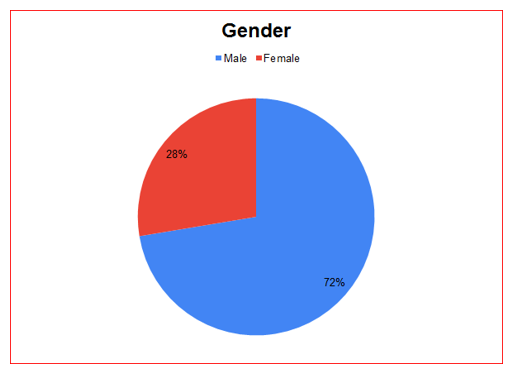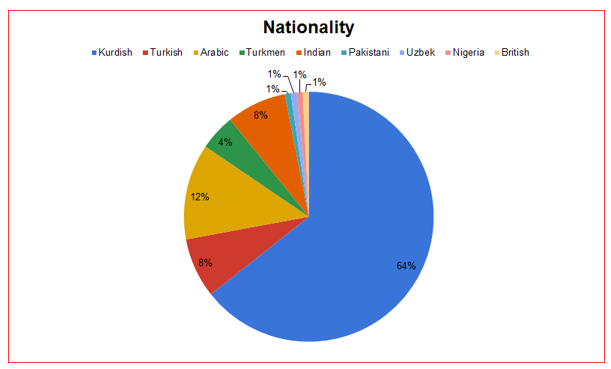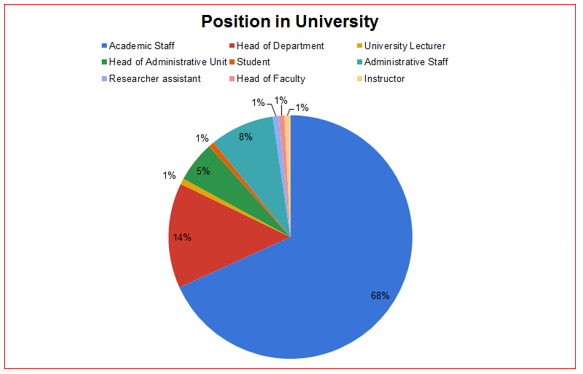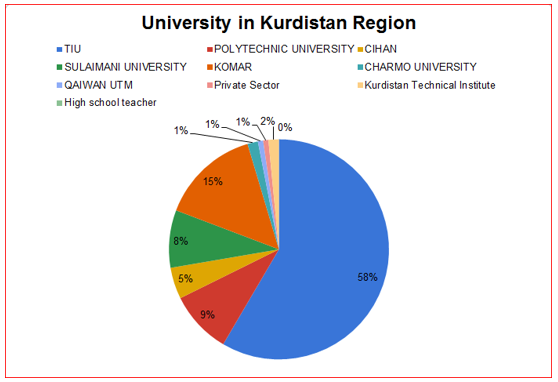Customer satisfaction in online meeting platforms: Impact of efficiency, fulfillment, system availability, and privacy
Satisfacción del cliente en plataformas de reuniones en línea: Impacto de la eficiencia, el cumplimiento, la disponibilidad del sistema y la privacidad
Abstract
As it is known business rely on the customers, which means the profitability of any company change depending on customer demand. Due to that, it is necessary to treat customers as the central factor of the market. In another meaning, Customer satisfaction is very important issue to a company’s business performance. In this regard, the purpose of this project was to determine the Impact of service quality on the customer satisfaction in the online meeting platforms. By means of service quality, we tested the impact of efficiency, fulfillment, system availability, and privacy on the customer satisfaction. Though conducting a survey data was collected. Different nationalities from various universities participated in this study including Kurdish, Turkish, Arabic, Turkmen, Indian, Pakistan, Uzbek, Nigerian and British with having different position such as head of the faculty, instructor, academic staff, head of the department and etc. in Kurdistan region of Iraq. Based on the result fulfillment, privacy issues were affected the customer satisfaction mostly.
Keywords: Customer, Satisfaction, Service, System Availability, Fulfillment and Effect, Online Meeting Platforms.
Resumen
Como es conocido el negocio depende de los clientes, lo que significa que la rentabilidad de cualquier empresa cambia en función de la demanda del cliente. Por eso, es necesario tratar a los clientes como el factor central del mercado. En otro sentido, la satisfacción del cliente es un tema muy importante para el desempeño comercial de una empresa. En este sentido, el propósito de este proyecto fue determinar el Impacto de la calidad del servicio en la satisfacción del cliente en las plataformas de reuniones online. Mediante la calidad del servicio, probamos el impacto de la eficiencia, el cumplimiento, la disponibilidad del sistema y la privacidad en la satisfacción del cliente. Aunque se recopilaron datos de la realización de una encuesta. Diferentes nacionalidades de varias universidades participaron en este estudio, incluidos kurdo, turco, árabe, turcomano, indio, pakistaní, uzbeko, nigeriano y británico con diferentes puestos como jefe de facultad, instructor, personal académico, jefe del departamento, etc. en la región de Kurdistán de Irak. Según el cumplimiento de los resultados, los problemas de privacidad se vieron afectados principalmente por la satisfacción del cliente.
Palabras clave: Cliente, satisfacción, servicio, disponibilidad del sistema, cumplimiento y efecto, plataformas de reuniones en línea.
Introduction
Any business around the world depends on the customer, product and profit always increase and decrease by customers’ demands, that is why it’s necessary to treat them as the kings of the market (Budur and Poturak, 2021a). Nowadays Customer satisfaction is very significant issue to company’s product, which measures the level of expectation between company’s product and customer expectation (Demir et al., 2020; Budur et al., 2018). In reality the customer satisfaction will affect company and product as well, because happier customer with price and quality means more products and more profit (Mohammed and Sahin, 2020).
If a company does not care about customers’ satisfaction, they will not expect them to care about the products (Powton, 2018). Despite fast financial and innovative changes, the present shopper is increasingly inquisitive, progressively taught and educated with what he/she precisely needs. These progressions likewise influence the requirements of firms. As indicated by Ehmke et al (2005), marketing the business is about how the position it to fulfill the clients' needs. Borden (1984) expressed that marketing manager must gauge the social powers and after that handle marketing components in his/her mix with the assets with which he needs to work when creating an advertising system to fit the necessities of a firm.
Related to the service quality issue, there are five scopes or diminutions of service quality which are very significant for customer satisfaction and in another meaning customer loyalty depend on blow dimensions of the service quality, including tangibility, reliability, responsiveness, assurance and empathy (Budur et al., 2019; Demir, 2020a; Khan and Yildiz, 2020). For better understanding, more clearly, tangibility is a very important point, because there is a relation between customer and tangibility issue in which tangible service lead gather customer attention on service quality by matching the tangible associated with these services provided. It is the presence of the physical, hardware, staff and correspondence materials (Demir et al., 2019a; Khan and Yildiz, 2020).
It is the capacity to achieve the promised service constantly and precisely. This dimension implies that the business area conveys on its guarantees about delivery, service arrangement as well as resolution of the problems and its value. Customer need to work with business area or companies that stay faithful to their obligations, especially their guarantees about the administration results and center help properties (Torlak et al., 2019; Hilal and Top, 2019). It will be clear by any business place that customer prefer and want the unwavering quality. This is another important point which effects the customer, this diminution refers to the inclination to support and help customers with deliver quick service (Demir et al., 2020). Quick responded by the companies will attract customer with dealing more with customer’s needs, questions and etc. all the points will make the relation much stronger between customer and service companies (Mohammed et al., 2020; Tariq et al., 2020). Assurance refers to the confident and trust of the customer, which means, any business company or market require to have a strong ability in order to inspire customers with good confident and trust (Ali et al., 2020; Demir et al., 2021). In addition, trust and confident about the markets and their product by customer lead to increase the profitability, that is why any market or business are required to be aware about this issue to gain more advantage and customer loyalty (Abdulla et al., 2020; Faeq, 2020).
There are two important points in this dimension including trust or confident with attention. This means, Empathy belongs to the customer attention and encourage them that the market or business company is best for satisfying them with good loyalty through trust issue (Budur, 2018b; Budur and Demir, 2019b). In another meaning, customer need good product with high quality and its business area, companies’ duty to make them feel comfortable with good trust and loyalty (Olunlade and Efozia, 2021). Moreover, service quality in the service industry could be defined as a tendency to focus on the requirement of customer and their trust and expectation about the products. And due to that, any market or business area need to focus on the factors affecting customer attention (Ahmed, 2020; Amin and Ahmed, 2020). According to the Gronross (1984) classification, service quality is divided into two parts including (technical and functional) quality, the first one refers to what customer serviced and the second one refers to service delivery process.Literature review
As it’s known, service quality name is a mixture of two words including, Service and Quality. Service refers to essential features of the particular service while quality refers to the use of mainly a user-based approach. And Service quality together quality refers to the value of service to the customer (Spacey, 2016).
The history of service quality begun with identifying five gaps by Parasuraman, Berry, and Zeithaml in 1985 that occur due to director insight of service quality.
The gaps which identified by mentioned researchers shown below
- Gap1: Alteration between buyer prospects and organization insights of consumer beliefs.
- Gap 2: Dissimilarity between supervision opinions of buyer beliefs and service quality qualifications.
- Gap 3: Dissimilarity between service quality qualifications and the service truly provided.
- Gap 4: Dissimilarity between customer needs and service delivery qualification
- Gap 5: Variance between expectation of customer about the product and reality of the products (Whitten, 2004)
More over Reliability, Responsiveness, Empathy & Tailoring, Competence & Diligence, Consistency, Safety & Security, Environments and User Interfaces considered as a common types of service quality (Spacey, 2016). Initial service quality concept has been modeled by Gronroos (1982, 1984). In addition, based on the service quality model Gronroos believe that, service quality is a combination of technical and functional in which functional service quality refer to the specification of receiving service to the customer and technical service quality refer to what customer receive. Moreover, Nordic model depends on disconfirmation worldview by contrasting apparent execution and anticipated help. This was the principal effort to quantify nature of administration. Gronroos model was general and without offering any method on estimating specialized and practical quality.
Now a days, new movement and scope of business require wide range of customer. It means customers are very essential and critical in business area (Budur and Poturak, 2021b). As it’s known, each business Area require to perform its job properly in order to create a trust between their products and customer trust, because it led to increase usefulness and much product profitability. Many researchers claim that, there is a good or strong relation between service quality and customer trust (Cronin et al, 2000). Customer satisfaction is another important issue for increasing profitability of the company’s products, in addition customer trust and customer satisfaction are close to each other (Demir, 2019b). Researchers recognized that both satisfaction and service quality are two dissimilar but interconnected concepts (Budur, 2018a). Also, customer satisfaction is able to increase and reduce the profit of the products which is called fluctuation, because good quality product makes the customer to choose it with high level of satisfaction. Due to that, customer satisfaction considered as a key indicator for business performance (Khan et al, 2018).
Empathy "sympathy" is utilized to depict a wide scope of encounters. Feeling scientists by and large characterize compassion as the capacity to detect others' feelings, combined with the capacity to envision what another person may be thinking or feeling (Demir, 2020b; Khan et al., 2018). The importance of empathy is that, it’s helpful to detect how other people care about and based on that, companies and other business area could respond based on their interest (Porturak et al., 2020; Rahman, 2016). There is a good relation between trust and empathy which lead to form the trust between companied and customers now days, most of the companies focused on the empathy issue in order to serve their customers much better (Alharthi and Khalifa, 2019). In addition, Trust and empathy are urgent in helping the associations become better work environment situations. This is on the grounds that the present business world is portrayed by quick globalization, which has prompted an expansion in the development and unmistakable quality of worldwide associations (Zardasht et al., 2020). This pattern towards globalization has expanded the difficulties looked by business associations, which need to deal with their representatives across societies, time regions, and hierarchical structures. As needs be, the truth of a worldwide market calls for business associations to expand sympathy aptitudes and ingrain trust among workers so as to have solid authoritative structure and to improve business endurance and progression (Rahman, 2016)
Responsiveness belongs to the quality and speed of the companies for their products based on the customer interest. Also, it determines the quality to provide customer service and communication. Responsiveness is very important to increase the profitability of the products because being fast and right will lead to make the customers much happy and satisfaction. This issue affects the trust, loyalty and satisfaction. And this will help high profitability and sailing much product (Meehan et al, 2012).
Assurance belongs to the operation control in order to have interested outcome of the issue. I addition, there is an important term that called customer service operation, the designation of this term will be very significant to protect the company as well as keep the customer satisfied. In any business there is a goal to keeping the customer satisfied, increase profitability and etc. that is why customer service will be properly designed to be sure about serving customers (Pakurár et al, 2019).
Based on its detention, reliability is the excellence of being reliable by the customer. Reliability issue is very important for customers because it’s a measurement of effect level of components on the system reliability (Durmaz, 2017). One basic approach to show this idea is to take customer at an arrangement framework. The least firm part in an arrangement framework has the best impact on the dependability of the framework (Gopalakrishnan, 2017)
Tangible considered as one of the service characteristics. It refers to the products which physically could be touched. Also, many researchers defined tangibles as a physical facility such as materials, equipment’s and etc. Because sometimes customer asset the products based on the external view or physical shape of the products. It means, the physical shapes or view of the products is very important to show that it is able to provide a good service. Also, researchers claim that, the tangibles have the same significance as empathy (Pakurár et al, 2019).
There is a relation between types and quality of the product with customer requirement or needs. Its man’s trust appears when realize what make the customer happy. Build bridges of trust with customers will be a good factor to get success and high profitability (Anand et al., 2017).
Consumer Satisfaction is characterized as an estimation that decides how pleased buyers or customer are with an organization's items (products), administrations, and capacities. Consumer loyalty data, including reviews and appraisals, can enable an organization to decide how to best improve or changes its items and administrations. Satisfaction is very significant issue to company’s product which it measures the level of expectation between company’s product and customer expectation (Tajeddini, 2015). Customer satisfaction will affect company and product as well, because happier customer with product quality and service means more products and more profit (Copley, 2017).
Any companies grow reached by customer loyalty. In addition, there is a strong relation between customer loyalty and customer satisfaction, because customer loyalty will not appear without having customer satisfaction (Tajeddini, 2016).
And its mentioned before. Customer satisfaction is affected by the product quality and services which provide by the companies to their customers. For any companies there will be some competition with other companies, and loyalty by the customer means choosing one companies items or products reliably over their competitors (Chambers & Ryder, 2018).
E-service quality could be defined as complete or total purchaser and customer assessments and evaluation of the quality-of-service delivery by a particular firm in the virtual marketplace (Santos 2003). Also, E-service quality is the contrast between clients' desires for administration execution needs the administration experience and their view of the administration got. In addition, E-service quality is very important, because some researchers claim that there is a good relation between customer satisfaction and loyalty with E-service quality. Also, it has a positive influence on the customer trust. (Kitapci et al., 2014; Mohammed et al., 2020). Also, Liao (2011) accepts that the exhibition of customer connections relies exceptionally upon the attributes of the e-service quality.
Methodology
Participants
The purpose of this project is to find the impact of technical and functional service quality on the customer satisfaction and loyalty in Kurdistan region. This chapter provides the main methods and procedure of this project. The demographic information of the participants contains as shown in the below chart, most of the participant were male and one third of them were female.

Figure 1. Participant Gender.
Nationality was the second demographic information of the participant which includes several different nations such as (Kurdish, Turkish, Arabic, Turkmen, Indian, Pakistan, Uzbek, Nigerian and British). As shown in the chart, most of the participant was Kurdish, while the second highest nationality was Arabic.

Figure 2. Participant nationality.
Position of the participant of the survey include several different positions such as (head of the faculty, instructor, academic staff, head of the department and etc.). As shown in the below chart, all mentioned positions were participated in order to evaluate the service quality of the program which they used for performing their jobs in the university.

Figure 3. Participant position in the university
Number of universities participated in the survey which include Komar university of science and technology, Charmo university polytechnic university and others which shown in the below chart.

Figure 4. Participant University in Kurdistan región.
Information was about the online meeting platform which they used for performing academic stuffs. Shown in chart … based on the collected information, ZOOM was the highest online platform which they used for their jobs, then Google meeting and both of them together.

Figure 5. Online meeting platforms that used by the participants.

Figure 6. model of the study.
Procedures
Based on the given information’s about the participant people a survey was performed to collect the information about their view about using inline platforms and the level of their satisfaction and loyalty. Excel software was used to calculate the data through calculation (co-variance, correlation and regression analysis) methods. Collecting data started from 8th of June and finished at 14th of June. Also, the way of calculating data include regression analysis
Research Findings
Based on their definition, Covariance and Correlation are the terms which belong to the measurement process between two variables; measurements include relationship and the dependency. In another meaning, it is covering the strength and direction relative between two variables (Demir, 2019a). The analysis Use the "Insert Citation" button to add citations to this document. Of correlation and covariance is significant for this project, because it’s helpful to collect the results in a scientific way.
Table 1.
Correlations

The independent variable is the variable the experimenter changes or controls and is assumed to have a direct effect on the dependent variable. The dependent variable is the variable being tested and measured in an experiment, and is 'dependent' on the independent variable (McLeod, 2019).
Table 2.
Regression analysis: efficiency and customer satisfaction.

As given in the Table 2, the adjusted R square is 65 percent, it shows that full efficiency explains 65 percent of the customer satisfaction. By another meaning, if there is no mistake in motivation, 65 percent of the customer satisfaction would be assured, Further the coefficient of the regression analysis is 0.74, it means that if the efficiency is increased 1 unit, the customer satisfaction would be increased 0.74 times more in the customer satisfaction. Beside the intercept has additive impact on the increase; however the impact is meaningful only if the relation is significant. The significant of a relation is tested by t statistics results. The table 1 reveals that t statistics of the model is 11.73. Normally the impact is considered to be significant in case the t statistics are above 1.96 and below -1.96. Therefore, we can conclude that the concerning impact is significant. Finally, the hypothesis is accepted due to the significant impact.
Table 3.
Regression analysis: fulfillment and customer satisfaction.

As given in the Table 3, the adjusted R square is 55 percent, it shows that full fulfillment explains 55 percent of the customer satisfaction. By another meaning if there is no mistake in fulfillment, 55 percent of the customer satisfaction would be assured, Further the coefficient of the regression analysis is 0.64, it means that if the fulfillment is increased 1 unit, the customer satisfaction would be increased 0.64 times more in the customer satisfaction. Beside the intercept has additive impact on the increase; however, the impact is meaningful only if the relation is significant. The significant of a relation is tested by t statistics results. The table 3 reveals that t statistics of the model is 9.62. Normally the impact is considered to be significant in case the t statistics are above 1.96 and below -1.96. Therefore, we can conclude that the concerning impact is significant. Finally, the hypothesis is accepted due to the significant impact.
Table 4.
Regression analysis: system availability and customer satisfaction.

As given in the Table 4, the adjusted R square is 44 percent, it shows that full system availability explains 44 percent of the customer satisfaction. By another meaning if there is no mistake in system availability, 44 percent of the customer satisfaction would be assured, Further the coefficient of the regression analysis is 0.61, it means that if the system availability is increased 1 unit, the customer satisfaction would be increased 0.61 times more in the customer satisfaction. Beside the intercept has additive impact on the increase; however, the impact is meaningful only if the relation is significant. The significant of a relation is tested by t statistics results. The table 1 reveals that t statistics of the model is 11.73. Normally the impact is considered to be significant in case the t statistics are above 1.96 and below -1.96. Therefore, we can conclude that the concerning impact is significant. Finally, the hypothesis is accepted due to the significant impact.
Table 5.
Regression analysis: privacy and customer satisfaction.

As given in the Table 4, the adjusted R square is 64 percent, it shows that full privacy explains 64 percent of the customer satisfaction. By another meaning if there is no mistake in privacy, 64 percent of the customer satisfaction would be assured, Further the coefficient of the regression analysis is 0.63, it means that if the privacy is increased 1 unit, the customer satisfaction would be increased 0.63 times more in the customer satisfaction. Beside the intercept has additive impact on the increase; however, the impact is meaningful only if the relation is significant. The significant of a relation is tested by t statistics results. The table 4 reveals that t statistics of the model is 11.61. Normally the impact is considered to be significant in case the t statistics are above 1.96 and below -1.96. Therefore, we can conclude that the concerning impact is significant. Finally, the hypothesis is accepted due to the significant impact.
Conclusion
To conclude, the purpose of this project was to determine the impact of e-service quality on the customer satisfaction and loyalty. In addition, several online meeting platforms are used in the world for online meeting issue, as it’s known some of them is free to use and the rest will charge the users. Though performing a survey which was collected from Parasuraman et al., (2005), we modified it to be appropriate for online meeting issue and used along different universities in Kurdistan region, number of result were collected, and the results belong to their view about different types of platform which they used for online meeting and academic stuff.
The covariance correlation and regression analysis were conducted through using the data of the survey in order to show the main determinant of the service quality. So the concluded results shown below:
- Based on the result fulfillment will provide a great effect on the customer satisfaction and loyalty, that is why companies need to focus on their customer satisfaction through providing good and proper service quality to increase their profitability.
- Also, privacy issue has significant effect on the customer trust, due to that managers need to make the platform much stronger in order to avoid sharing data with any other party and protect their customer.
In addition, this project is conducted in Kurdistan region only that is it’s not possible to generalize the results for all universities around the world. Also, there may be different expectation about the platform which used in the whole world.
